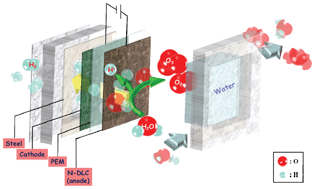Electrochemical reduction of high-efficiency ozone generation through nitrogen-doped diamond-like carbon electrodes
Abstract
An aqueous ozone-generation device is established in this study by combining a nitrogen-doped diamond-like carbon-based (N-DLC) anode, a proton exchange membrane, and a carbon cloth cathode. N-DLC retains the properties of a carbon material, such as high corrosion resistance, toughness, bio- and eco-friendliness, wide overpotential range, and chemically inert properties. The N-DLC anode is characterized using scanning electron microscopy for surface morphological observation, X-ray photoelectron spectroscopy for elemental analysis, and Raman spectroscopy for determining its vibration mode. The ozone generation efficiency is correlated to the reaction area, thickness of N-DLC covering, input water flow rate, applied voltage, and series connection of the electrodes. The relative ozone concentration is monitored using the oxidant reduction potential sensor. Furthermore, electrochemically produced aqueous ozone can sterilize water of Escherichia coli via ozone oxidation.


 Please wait while we load your content...
Please wait while we load your content...